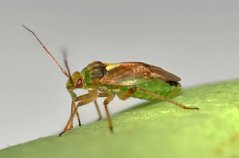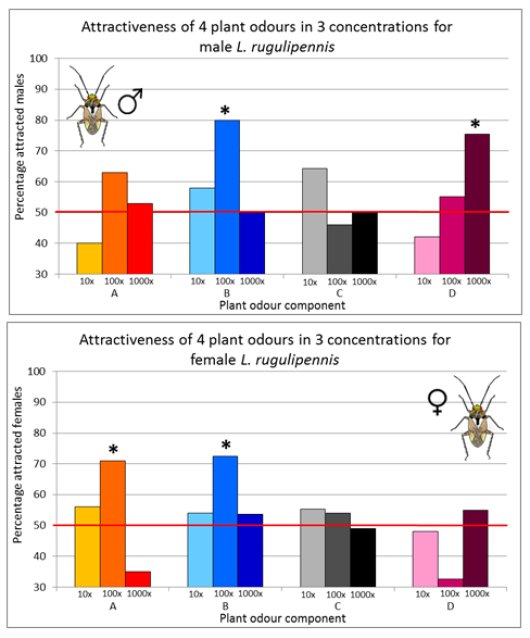How can we biologically control the European tarnished plant bug and other plant bugs in the greenhouse? Wageningen UR, Entocare biocontrol CV and breeders have been working on a solution for many years. While a trap with pheromone attractant appears to be a good way, initial results show that the trap requires further optimisation to not only attract bugs but capture them as well. The right combination of attractants also needs to be found.
Plant bugs, including the European tarnished plant bug and the common nettle bug, can do serious damage to crops such as aubergine, cucumber and chrysanthemum. Even small numbers have an effect: abortion of the flower in aubergines, stem and fruit damage in cucumbers and splits in chrysanthemums.
To prevent damage, breeders start eradicating the bugs as soon as they are spotted. The problem is that although the bugs disappear, biological agents that control other pests also perish.

Breeders therefore need a method that helps them decide when to combat the bugs. In addition they are looking for a biological agent; for example by luring the bugs to a place where a biological agent awaits them.
Trap lures bugs
The scientists set a season-long trap in the greenhouse with a pheromone attractant that had previously only been used outside. And it worked. The problem, however, was that it only attracted male bugs and not females. Tests in the lab showed that adding several specific plant aromatics to the mix also attracted the females, but this was not as effective in practice; probably because the amount of these added plant substances that should be emitted by the traps is very specific: too much scares the bugs off, while too little fails to attract them.
So the traps lured the bugs, but it still wasn’t clear what percentage of the bugs present were actually caught. Although the trap was somewhat effective, it did not seem ideal for capturing all bugs: video recordings in a separate study showed that less than five per cent of the landings on the trap resulted in capture.
Biological control with entomopathogenic fungi
In addition to research with the lure trap, the scientists also tested other biological control methods, such as the use of insecticidal fungi, also known as entomopathogenic fungi. The trick is to cover the bugs with sufficient fungal spores. The more spores, the greater the chance that the fungi eradicate the bug over time. So far, the scientists have succeeded in increasing the amount on the bugs by a factor of three to four.
The next issue is whether the combination of luring, infecting and transferring the fungal spores to other members of the species (through contact between males and females when they mate, for example) actually helps combat the plague.
Further research
In the coming year the research will therefore also focus on:
- Better regulating the release of aromatics that lure female bugs so that it also works in practice.
- Finding the right combination of substances that lure both males and females.
Improving the trap so it captures more bugs is part of a new project submitted to TKI for financing.e.
Project Controlling pest bugs in the greenhouse
Client: Dutch Ministry of Economic Affairs via TKI agency Top Sector Horticulture & Starting Materials. Innovation theme: More and better with less

Males and females of the European tarnished plant bug (Lygus rugulipennis) respond differently to a number of tested odours (bars marked with an asterisk are significantly attractive for the bugs). The different concentrations of the odours offered appear to be important for response as well (10x, 100x or 1000x dilution). In total 60 adult bugs (30 males and 30 females) for each odour and each concentration were tested.